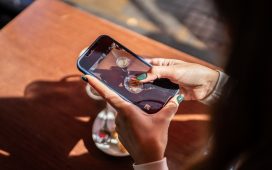The designer Rafael Prieto is not the sort to treat work and the rest of his life as two distinct realms. “It’s all, in a way, a pleasure,” he says, adding, “they mix well.” A few years ago, he decided to make a loft in a 19th-century building in Manhattan’s TriBeCa neighborhood both his home and office, so it’s out of that space that he runs Savvy Studio, the agency he co-founded in 2011 that offers branding and graphic and interior design — it’s responsible for the look of Mast Books in the East Village and much of the Maidstone Hotel in East Hampton — as well as various side projects. One, called Casa Bosques, is a multipronged endeavor driven by Prieto’s personal passions that encompasses a line of artisanal chocolate. “I tend to poke around because there are always little tidbits — chocolates, a prototype of a lamp, paper samples,” his longtime friend the artist Laila Gohar says of the apartment, where Prieto also entertains.
Last month, he invited friends over for dinner. It was an opportunity to get together before the onslaught of more elaborate holiday celebrations, and to test out some of his recent designs — a low-slung white oak table and four one-of-a-kind stools. Prieto, 41, who grew up in northern Mexico, spends part of each year in Mexico City, which is home to two of his other ventures: the Casa Bosques art bookstore and, above it, the Casa Bosques Pensión, a three-room guesthouse for which he designed the chairs, beds and armoires, drawing from the work of the architect Le Corbusier and the artist Franz West, though he doesn’t like his references to be too obvious. “They’re democratic pieces that aren’t trying to yell ‘design,’” he says. He also has a line of bone-shaped lights, Marrow, with his boyfriend, the artist Loup Sarion. But the table and stools, the latter consisting of slightly raised platforms inspired by his experience sitting on tatami mats during a nearly monthlong trip to Japan — “it humbles you to be so close to the ground,” he says — are among the first proper furniture designs that he’s put up for sale (they’re available now at his studio and will be, starting next week, at 180 the Store on nearby Duane Street).
Like much of Prieto’s work, the pieces’ final forms came out of conversations with friends about how their respective skills and sensibilities might be combined — “in a very simple way,” he specifies. In this case, he partnered with the Brooklyn-based carpenter Andrin Widmer on the table and stool platforms and with Valerie Name Bolaño of the New York-based interior design firm Spoliâ on the upholstered cushions that sit atop the stools. Prieto and Name Bolaño chose four handwoven options from her archive of luxurious deadstock textiles: a cream cashmere, a blue-and-brown bouclé, a black cotton velvet patterned with off-white ovals and a wool jacquard with red and green tones. The ceramist Natalie Weinberger produced rocklike pottery buttons (again, West was an influence but so were some stones Prieto came across in Isle au Haut, Maine), one of which has been sewn into the center of each cushion. Prieto, who plans on releasing other iterations of the stools — the results of other conversations — and on including two of these future designs in a show of his work set to open at Emma Scully Gallery this spring, was careful to make them big enough so that a sitter can cross or extend their legs. “You play around and get comfortable,” he says.
Not that his guests — Sarion; Gohar; the chef Ignacio Mattos; the music producer Emile Haynie; the artist Yto Barrada; the fabric artist Megumi Shauna Arai; the global director of marketing and communications at Lehmann Maupin gallery, Sarah Levine; and the designer, restaurateur and mixologist Arley Marks — experienced the furniture right away. The evening began with mingling around the kitchen island, on which Prieto laid out thin slices of beets and radishes that he’d pickled the day before, uni, oysters, tinned seafood collected on his travels around Europe (Lisbon, Verona) and chunks of porridge bread from the neighborhood grocery Rigor Hill Market. “That way, people arrive and are free to nibble on something, get a glass of wine or sparkling water and go around speaking to people without being directed,” he says. Eventually, the group made its way to the table — those not on stools sat on the floor or on Prieto’s puffy ’70s-era couch — to dine on a salad and a smoked whitefish from Russ & Daughters. Ever the designer, Prieto liked that the fish’s slick surface echoed that of the seafood served earlier. And he was all right with not having prepared a more technically ambitious spread. “I want to be able to spend time with my guests and not be too concerned about what I’m cooking and trying to be the perfect host,” he says.
He does try to create memorable experiences, however. For dessert, he presented chocolate modeled after bars of soap. The latest offering from Casa Bosques Chocolate, they’re intended to tap into childhood memories. “Sometimes when you were a kid, you wanted to eat the soap. Now, it’s made it onto the table,” says Prieto, though the taste is rather different. He got the idea after a friend gave him a vintage olive oil soap from Aleppo, Syria. “I hadn’t seen one quite like that in years and was attracted to the universality of the form — it’s the soap you see when you close your eyes,” says Prieto, who subsequently found other decades-old bars from traditional soap capitals such as Marseille, France, and the Greek island of Samos. The chocolate that resembles the bar from Aleppo nods to the region’s cuisine with its filling of tahini and preserved lemons, while the one channeling the Samos soap contains sunflower seed butter and cacao nibs. “They’re really rich and delicious,” says Gohar, “and they’re just a fun thing — like a party trick but in a good way.”
Below, Prieto shares his tips for creating a festive, laid-back meal, though his primary piece of advice is not to overstress. “It’s meant to be enjoyed,” he says. “A lot of the things that I make in my life are meant to be. You push but not too much.”
Keep It Loose
As far as the designer’s concerned, there’s no need to start the main event right away or even at a set time. “It’s rare that you would sit right when you arrive at my house, because there’s this loft energy, and I like that lack of formality,” says Prieto, who makes a point of observing how guests move around each other before heading to the table. “You time it based on the energy of people.”
Accept Help
During the first part of the evening, while Prieto was still getting things ready, his friends offered to pitch in, and he was happy to involve them. “I had the escarole and chicory out for the salad and Laila asked what I wanted to do with it. I said, ‘I’ve got these anchovies and this juice, so the idea is to make an anchovy dressing,’ and she just did it,” says Prieto. Marks mixed bitters and mezcal cocktails, and Levine helped set the table. “It turns it into a collaborative exercise and facilitates conversation,” says Prieto. “Suddenly, you see people doing things for each other, and you break the ice in an organic way.”
Don’t Play the Chef
“People are coming for you and not specifically to eat your food. I really feel that it’s more about the moment and having things that we all like, like small mussels in lemon juice,” says Prieto. In other words, stay true to your abilities and tastes. “The menu was very me — if I go to a bar and there’s a choice to have anchovies or sardines, I’ll get that with some bread — and my friends know that. They’re not going to show up and find I’ve done a big chicken or filet mignon,” he says.
Feed the Eye
In addition to being attuned to the look of the food, Prieto was thoughtful about the tableware. He used a variety of plates and platters by Atelier Lips, a New York ceramics studio run by two sculptor friends of his. “They make small things and big things, and each plate has different colors and details, so, combined with the tinned fish and the other elements, it was all a language,” he says. (Atelier Lips also created a “soap dish” that can be purchased with the chocolates.) For glasses, Prieto selected bicolor, hourglass-shaped designs by Mamo, which Marks runs with Jonathan Mosca, and “these really old-school ones that Laila gave me years ago,” he says. There was no tablecloth because Prieto wanted to show off the table itself but, off to the side, there was a bouquet — an arrangement of thistle that Sarion picked up from Sunny’s Florist on his way to dinner.






